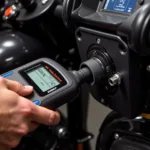The Craftsman OBD2 Scan Tool Model 1681 is a popular choice for car enthusiasts and DIY mechanics. This handheld device offers a simple way to read and clear diagnostic trouble codes (DTCs), providing valuable insights into your vehicle’s health.
Understanding OBD2 Scanners and Their Importance
Before diving into the specifics of the Craftsman 1681, it’s essential to understand the basics of OBD2 scanners. OBD2 stands for On-Board Diagnostics, generation two, a standardized system implemented in most vehicles manufactured after 1996. This system allows your vehicle’s computer to communicate with a scan tool, providing access to data about engine performance, emissions, and other vital systems.
An OBD2 scanner, like the Craftsman 1681, acts as a decoder, translating this data into an understandable format. This information empowers you to:
- Diagnose engine problems: Identify the source of that pesky check engine light.
- Monitor vehicle performance: Check real-time data on speed, RPM, and other parameters.
- Assess emissions readiness: Determine if your vehicle will pass emissions tests.
- Reset maintenance reminders: Clear service lights after routine maintenance.
Key Features of the Craftsman OBD2 Scan Tool Model 1681
The Craftsman 1681 is a budget-friendly OBD2 scanner that packs a punch. Some of its notable features include:
- Code Reading and Clearing: Read and clear both generic (P0XXX) and manufacturer-specific trouble codes.
- Live Data Stream: View real-time sensor data, such as engine speed, coolant temperature, and oxygen sensor readings.
- Freeze Frame Data: Access a snapshot of vehicle data at the moment a fault code was stored.
- Vehicle Compatibility: Compatible with a wide range of vehicles (check compatibility before purchase).
- Easy-to-Use Interface: A straightforward interface with a clear LCD screen and simple navigation buttons.
How Does the Craftsman 1681 Compare to Other Scanners?
While the Craftsman 1681 offers excellent value for its price, it’s crucial to consider its limitations. As a basic scan tool, it may not provide the advanced functionality of higher-end models. Here’s a quick comparison:
| Feature | Craftsman 1681 | Advanced Scanners |
|---|---|---|
| Code Reading/Clearing | Yes | Yes |
| Live Data Stream | Basic | Advanced (more parameters) |
| Bi-Directional Controls | No | Yes (on some models) |
| ABS/SRS/Transmission Diagnostics | No | Yes (on some models) |
| Graphing/Data Logging | No | Yes (on some models) |
| Price | Budget-friendly | More expensive |


Is the Craftsman 1681 Right for You?
The Craftsman 1681 is a solid choice for:
- DIY enthusiasts: Those who prefer handling basic car maintenance and troubleshooting.
- Car owners on a budget: An affordable way to gain insight into your car’s health.
- Those new to OBD2 scanners: A great entry-level scanner with a user-friendly design.
However, professional mechanics or those seeking advanced diagnostics might need a more sophisticated scan tool with bi-directional controls, ABS/SRS coverage, and other specialized features.
Tips for Using the Craftsman 1681 Effectively
Here are a few tips to make the most of your Craftsman 1681:
- Consult your vehicle’s repair manual: This invaluable resource provides specific code definitions and troubleshooting procedures for your make and model.
- Record codes and freeze frame data: Before clearing any codes, note them down along with the freeze frame data for future reference.
- Start with the basics: When diagnosing a problem, begin by checking for loose gas caps, faulty spark plugs, or other common issues before assuming a more complex problem.
- Use online resources: Websites and forums dedicated to your vehicle model can offer insights from other owners who might have encountered similar issues.
Conclusion
The Craftsman OBD2 Scan Tool Model 1681 is a valuable tool for anyone looking to gain a deeper understanding of their car’s health. While not as feature-rich as some high-end scanners, it provides a reliable and affordable way to diagnose engine problems, monitor performance, and clear trouble codes. Remember to use it responsibly, consult your vehicle’s repair manual, and always prioritize safety when working on your car.

